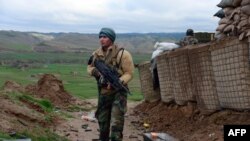A new report by Afghanistan’s hard-line Taliban describes the territory they control across the country.
The report, titled Percent Of Country Under The Control Of Mujahedin of Islamic Emirate, provides no overall figure of how much of the country’s more than 650,000 square kilometers the insurgents control.
Instead, it gives a lengthy breakdown of Afghanistan’s more than 400 districts across its 34 provinces. Most Taliban gains were made in the years following the departure of a majority of NATO troops from Afghanistan by the end of 2014.
The report first mentions the districts the Taliban completely control in each province, followed by the regions they mostly control or contest. The report does mention territories where the Taliban still only carry out guerilla attacks or are merely present.
Overall, the Taliban claim to control more territory and population than a recent report by a U.S. watchdog said they controlled or influenced. A quick count of the districts the Taliban claimed to fully control put the number at 45.
The Long War Journal website attempted to compare the Taliban claims with a map of Afghanistan. The regions shown in black are completely controlled by the Taliban, while those shown in red and orange are contested.
In its quarterly report to U.S. Congress in January, however, the Special Inspector General for Afghanistan Reconstruction (SIGAR) said the Taliban only controlled nine districts.
Quoting U.S. military figures from Afghanistan, the report said Kabul controlled more than 57 percent of the country’s 407 districts. These include all major population centers.
“According to USFOR-A (U.S. Forces Afghanistan), the number of districts under insurgent control or influence rose 2 percent from August 30 to November 15, 2016, to 10.1 percent of the country’s total districts, and the number of contested districts rose 4.2 percent over the same period to 32.7 percent of all districts,” the report noted.
A table based on these figures shows that Taliban control is increasing.
But General John Nicholson, commander of the U.S. forces in Afghanistan last year, said the insurgents mostly control rural regions. Only a fraction of Afghanistan’s estimated 30 million people live in these areas.
One of the most alarming aspect of the Taliban’s claim is that the insurgents are poised to overrun key Afghan provinces. Helmand, Afghanistan’s largest province, for example, is mostly under Taliban rule. The Taliban report claimed they control 95 percent of the provincial capital, Lashkar Gah.
However, this appears to be an exaggerated given that the city of 200,000 is protected by thousands of Afghan troops who are on the offensive to drive the insurgents further away from the city.
While the Taliban claim to be present in all provinces of the country, their reliance on their own administrative divisions makes it difficult to even match their claims to the administrative system employed by the Afghan government.
With the insurgents expected to announce a spring offensive soon, the current year might prove to be another violent episode in nearly four decades of war in Afghanistan.
Last year, the United Nations listed a record-high 11,418 civilian casualties. The organization said the Taliban and other insurgent groups were responsible for a majority of these casualties.
fg/









